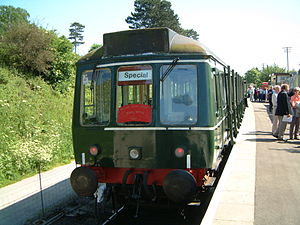British Rail Class 117
| British Rail Class 117 | |
|---|---|

51402 at Northampton & Lamport Railway. This vehicle, along with 51367 has since moved to the Strathspey Railway.
|
|
| In service | 1959–2000 |
| Manufacturer | Pressed Steel Company |
| Number built | 123 cars (42 DMBS, 42 DMS, 39 TCL) |
| Formation | DMBS-TCL-DMS |
| Operator(s) | British Rail |
| Specifications | |
| Car length | 64 ft 0 in (19.51 m) |
| Width | 9 ft 3 in (2.82 m) |
| Height | 12 ft 8 1⁄2 in (3.87 m) |
| Maximum speed | 70 mph (113 km/h) |
| Weight |
Power cars: 36 long tons 0 cwt (80,600 lb or 36.6 t), Trailer cars: 30 long tons 0 cwt (67,200 lb or 30.5 t) |
| Prime mover(s) | BUT (AEC) then BUT (Leyland), of 150 hp (110 kW), (both types), two per power car |
| Power output | 600 hp (450 kW) per 3-car set |
| Transmission | Mechanical |
| Safety system(s) | AWS |
| Multiple working | ■ Blue Square |
| Track gauge | 4 ft 8 1⁄2 in (1,435 mm) |
The British Rail Class 117 diesel multiple units (DMUs) were built by Pressed Steel from 1959 to 1961.
When first introduced, these three-car units were all based with the similar Class 121 single carriage (railcar) units on British Railway's Western Region for suburban work out of London Paddington and Cornwall. The units were largely based at Southall, and Plymouth Laira depots. The units remained here for many years working these services.
In the 1980s, expiry of other DMUs facilitated moves for some units from the Western Region to Birmingham, as below, and Scotland, prior to the delivery of new units to replace them. They were given refurbishments.
The first shake up in ownership occurred in the late 1980s, when the Scottish, Welsh, Cornish and Birmingham based units were transferred to Provincial Services, later Regional Railways, in the sectorisation of British Rail, while the Southall-based units transferred to Network SouthEast.
They were replaced on the lines out of Paddington when the Class 165 'Network Turbo' units came into service in the early 1990s.
They soldiered on in the former Western Region until replaced by Class 150 and Class 153 DMUs. An attempt was made to remove them from Cornish work using Class 142 "Skipper/Pacer" units, but these non bogie units proved to be a liability on the tight Cornish branchline curves, increasing rail and wheel wear, moving to the North of England instead. They were finally replaced with the advent of more Class 150s and Class 153s freed up from other areas. They continued to work in Scotland until the turn of the millennium, where they were replaced with class 156s and Class 170 Turbostar DMUs.
...
Wikipedia
